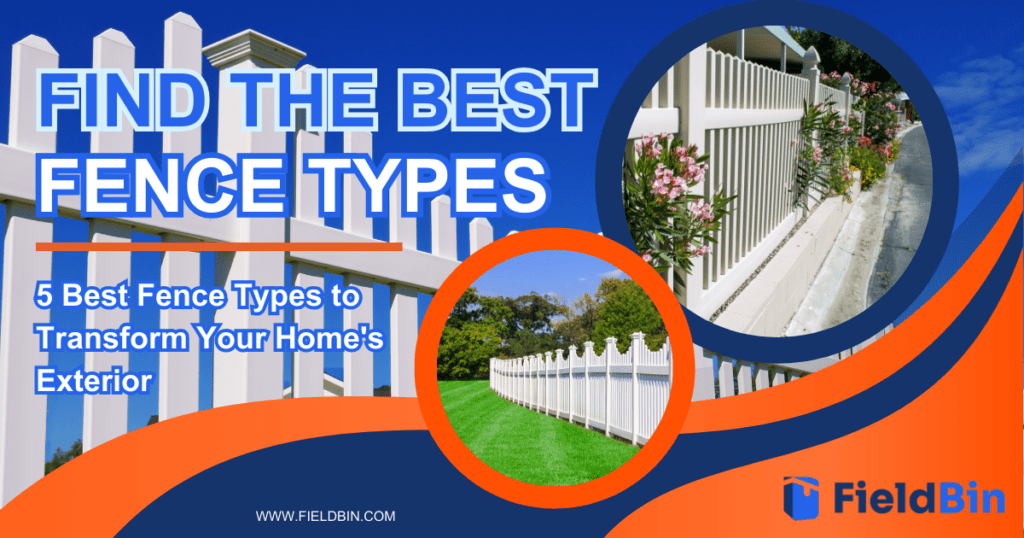Your dream home deserves a fence that’s just as perfect, and finding the best fence types is key to achieving that. It’s more than a simple boundary; it’s a frame that showcases your property, gives you much-needed privacy, and adds a layer of security.
When we first moved into our place, the old fence was the first thing we wanted to change. It really brought down the whole look of the house. And let’s be honest, picking a new one felt like searching for a needle in a haystack. There are so many options out there for the best fence types! Choosing the right fence for your property can feel overwhelming, but we’re here to help.
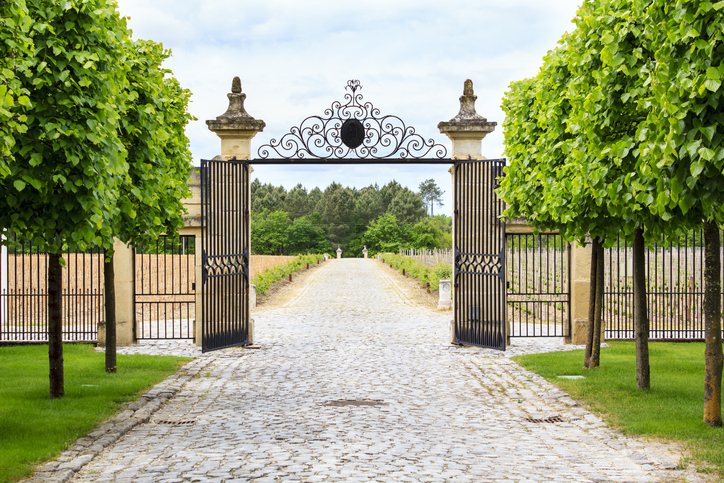
Starting Your Fence Journey: Find the Best Fence Types for Your Needs
But hey, we’ve been there, and we’re here to help. Imagine pulling up to your house and the first thing you see is a fence that complements your house and yard beautifully. It makes you smile, keeps things safe, and elevates the entire look of your property. That’s exactly the feeling we got when we finally installed our new fence!
Now, choosing the best fence types isn’t rocket science, but it’s not as simple as pointing at a picture and saying “I want that one.” Your home’s style, your lifestyle, your budget, and even local rules all matter. We learned this the hard way, so let us guide you. Think of this as your roadmap to finding the best fence types you’ll love for years to come.
Setting the Scene: Determine the Best Fence Types for Your Property
Before we dive into all the exciting fence designs and materials, let’s pause and figure out what you really need and want from your fence. Think of it like planning a road trip – you wouldn’t just hop in the car without a destination in mind, would you?
Purpose: What Do You Need Your Fence to Do?
So, what’s the main reason you want a fence?
- Privacy: Do you dream of a secluded outdoor space where you can relax without nosy neighbors peeking in? I know I do! The advantages of installing a privacy fence are numerous. No one likes feeling like they’re on display in their own backyard.
- Security: Are you looking for a sturdy barrier to protect your loved ones and belongings? We all want to feel safe and secure at home.
- Boundaries: Or maybe you simply need to clearly mark where your property ends. Sometimes it’s just about knowing where your space begins and ends.
- Looks: Is your main goal to boost your home’s curb appeal? A beautiful fence can make a huge difference. In fact, according to the National Association of Realtors, good landscaping, which includes the best fence types, can add up to 28% to the overall value of your home.
Architectural Harmony: Choosing the Best Fence Types to Match Your Home
Your home has its own style, and your fence should match. Think of it like choosing the right outfit – everything needs to work together to create a polished look.
- Look for the best fence types that complement the overall look and feel of your house. This Old House Magazine has a fantastic guide on pairing fence styles with different architectural types.
- Avoid fences that clash. A mismatched fence can really throw off the whole vibe of your home.
Budget: Setting Realistic Expectations
We all have dream projects, but it’s important to be realistic about your budget. Fence installation costs can vary greatly depending on the materials, size, and complexity of the design.
- Decide how much you’re comfortable spending on your fence.
- Don’t forget to factor in installation, permits, and future maintenance. These costs can add up! The Fence Guides offers a handy cost guide for different fence types to help you get a sense of what to expect.
- Explore options for doing it yourself (DIY) or hiring a professional. DIY can save you money, but sometimes it’s worth it to let the pros handle it, especially for complex designs or materials.
Maintenance: How Much Time Will You Invest?
Fences need care, just like anything else. Some are high-maintenance, like a pet that needs constant attention. Others are more low-key. Fence maintenance is important to guarantee that your investment lasts for years to come
- Think about how much time you’re willing to spend on upkeep.
- If you’re busy or just prefer to relax on weekends, choose materials that are easy to maintain.
- Do a bit of research on how to care for different types of fences. A little knowledge can go a long way in keeping your fence looking its best for years to come.
Local Regulations: Staying on the Right Side of the Law
Nobody wants to get in trouble with the neighbors or the city, so it’s crucial to check the rules.
- Look into local zoning laws and any rules from your homeowner’s association.
- Pay attention to fence height limits, allowed materials, and style restrictions.
- Make sure your fence project follows all the rules. It’ll save you a lot of hassle down the road.
By taking the time to think through these factors, you’ll be well on your way to choosing the perfect fence. Once you have a good understanding of your needs, preferences, and what’s allowed, you can start exploring all the amazing options and find the one that truly completes your dream home.
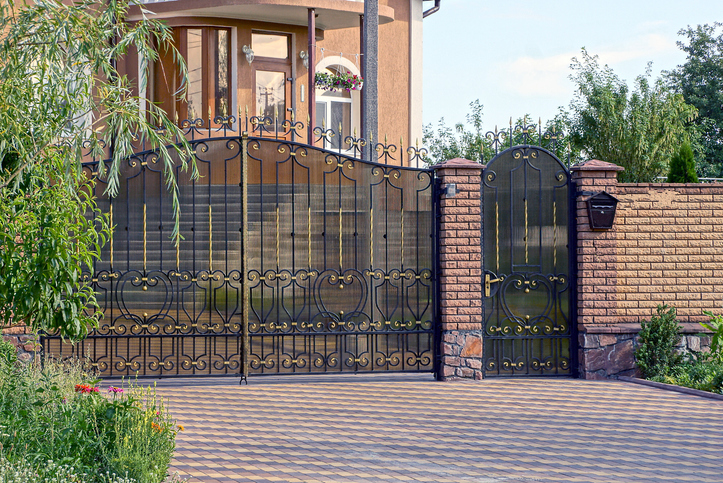
Exploring Popular Materials: The Best Fence Types for Every Style
The material you choose is like the backbone of your fence – it determines its look, feel, and how long it’ll last. So, let’s dive deeper into some of the most popular fence materials and their unique characteristics to help you make an informed decision. Fence material comparison is key to understanding which option suits your needs best. Whether you’re looking at wood, vinyl, metal, or composite, knowing the best fence types can make a big difference.
Wood Fences: Timeless Appeal
There’s an undeniable charm to a classic wood fence. It has a warm, natural look that complements many architectural styles. From the rustic appeal of a split-rail fence to the classic elegance of a picket fence, wood offers endless possibilities for customization. I still remember visiting my grandparents’ house as a child, and their white picket fence always felt so welcoming. If you’re up for a DIY project and want the classic look of wood, you might consider how to build a wooden fence.
- Pros:
- Natural beauty
- Can be customized with stains, paints, and decorative details
- Generally budget-friendly upfront
- Cons:
- Needs regular maintenance, like staining and sealing
- Susceptible to rot, insect damage, and warping
- Can be a fire hazard in dry climates
Popular wood choices include:
- Cedar: Naturally resists rot and insects
- Redwood: Durable and attractive
- Pressure-treated pine: Affordable, but needs regular maintenance
According to AGDAILY, wood remains a popular fencing material due to its availability and versatility, though it requires upkeep to maintain its durability over time.
Vinyl Fences: Low-Maintenance Living
If you’re looking for a fence that’s as carefree as it is beautiful, vinyl might be your answer. It’s durable, resistant to moisture and pests, and doesn’t fade easily. Best of all, it requires very little upkeep. When we were considering fence options for our own home, the low-maintenance aspect of vinyl was a major selling point.
- Pros:
- Virtually maintenance-free
- Resistant to rot, insects, and harsh weather
- Available in a wide variety of styles, colors, and textures
- Cons:
- Can be more expensive than wood upfront
- Might not be the most environmentally friendly
- Can become brittle in very cold temperatures
Vinyl fences have gained popularity due to their resilience and low maintenance needs. The Spruce notes that while vinyl may have a higher initial cost, its long-term savings in maintenance make it a viable choice for many homeowners.
Metal Fences: Strength and Style
For a modern, sleek look and exceptional durability, metal fences are a great option. They offer a sense of security and can last for decades with minimal maintenance. I’ve always admired the wrought iron fences in historic neighborhoods – they add a touch of elegance.
- Pros:
- Extremely durable and long-lasting
- Low maintenance
- Offers a variety of styles
- Cons:
- Can be one of the pricier options
- May require professional installation
- Depending on the style, might offer less privacy
Popular metal choices include:
- Aluminum: Lightweight and rust-resistant
- Wrought iron: Ornate and elegant
- Steel: Strong and secure
Composite Fences: The Best of Both Worlds
Composite fences offer the beauty of wood with the durability and low maintenance of vinyl. Made from a blend of wood fibers and recycled plastic, they are a sustainable and long-lasting choice. A friend of mine recently installed a composite fence, and it looks just like wood but without the worry of rot or termites!
- Pros:
- Resistant to rot, insects, and fading
- Requires minimal maintenance
- Environmentally friendly
- Cons:
- Can be more expensive than wood
- Fewer color options
Other Materials: Unique Best Fence Types to Consider
If you’re looking for something truly unique, consider alternative materials like bamboo or living fences (hedges).
- Pros:
- Unique and attractive
- Eco-friendly and sustainable (especially living fences)
- Cons:
- May require specialized installation or care
- Can be less durable
- Living fences require regular trimming
Making Your Choice: Factors to Consider
Each of the best fence types has its own unique pros and cons. It’s important to weigh these carefully, considering your budget, desired aesthetic, maintenance preferences, and the specific needs of your property. Remember, the perfect fence material is the one that strikes the right balance between beauty, function, and longevity for your dream home.
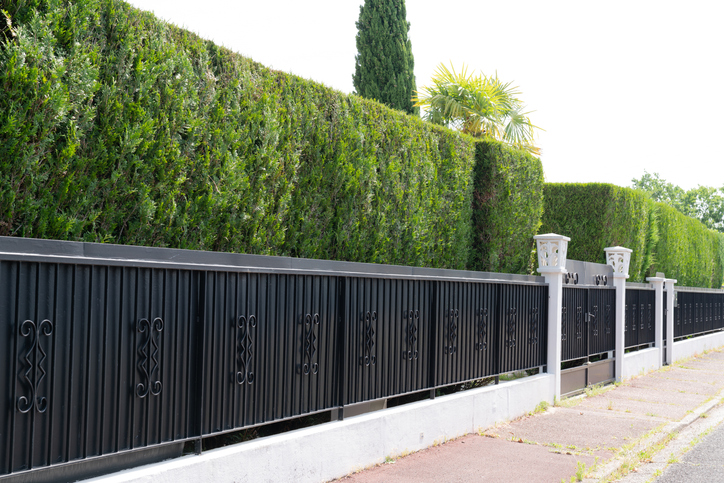
Matching Fence Styles to Your Architecture: The Best Fence Types for Different Homes
Your home’s architecture sets the tone for your entire property, and your fence should be a natural extension of that style. It’s about creating a cohesive look, much like assembling a well-coordinated outfit. Consider these best fence types to match different architectural styles:
Traditional Homes: Classic Choices
If your home has a traditional style, think classic and timeless. For example, a white picket fence surrounding a charming colonial house is iconic for a reason. Stately Georgian homes might benefit from simple post-and-rail fences, which add formality. Even cozy cottages look beautiful with a lattice-top fence, offering a perfect backdrop for climbing plants like roses.
- Key elements: Picket fences, post-and-rail fences, lattice-top fences
- Materials: Wood, often painted white or stained naturally
- Focus: Clean lines and symmetry
The aesthetic appeal of traditional homes, with their emphasis on proportion and simplicity, is often mirrored in the fences that surround them. Fences in historic styles can significantly enhance the charm and value of traditional homes by complementing their period features .
Modern Homes: Sleek and Minimalist
Modern homes demand fences that match their clean lines and minimalist style. Horizontal slat fences, made from wood or metal, maintain openness while providing privacy. A minimalist metal panel fence has a contemporary elegance, while frameless glass fences offer unobstructed views for a truly modern touch.
- Key elements: Horizontal slat fences, metal panel fences, frameless glass fences
- Materials: Wood, metal, or glass
- Focus: Clean lines and geometric shapes
Modern architectural design emphasizes simplicity and functionality, and this is reflected in the choice of fences. As noted by Architectural Digest, modern fences often incorporate sustainable materials that align with the eco-conscious principles of contemporary design .
Rustic Homes: Natural Beauty
Rustic homes, often characterized by their earthy tones and natural materials, need fences that complement their rugged beauty. A split-rail fence, evocative of the countryside, fits this style perfectly. Alternatively, board-on-board fences offer added privacy without sacrificing a rustic aesthetic, while a wattle fence woven from willow branches introduces an organic, unique element.
- Key elements: Split-rail fences, board-on-board fences, wattle fences
- Materials: Wood, willow, or bamboo
- Focus: Natural textures and earthy colors
Rustic designs are rooted in nature, and the choice of fence should reflect that connection.
Contemporary Homes: Breaking the Mold
Contemporary homes offer a blank canvas for fence designs. This style is all about innovation and individuality, so don’t hesitate to mix materials like wood and metal for contrast. Bold colors or geometric patterns can make your fence a statement piece that matches the architectural creativity of your home.
- Key elements: Mixed material fences, geometric patterns, bold colors
- Materials: Wood, metal, composite, glass, or a combination
- Focus: Individuality and innovation
Contemporary architecture embraces artistic freedom, and fences are no exception.
By selecting the best fence types for your home’s architecture, you enhance its overall appeal and create a cohesive, inviting environment. Don’t be afraid to experiment—your fence is an extension of your home, and it should tell your story.
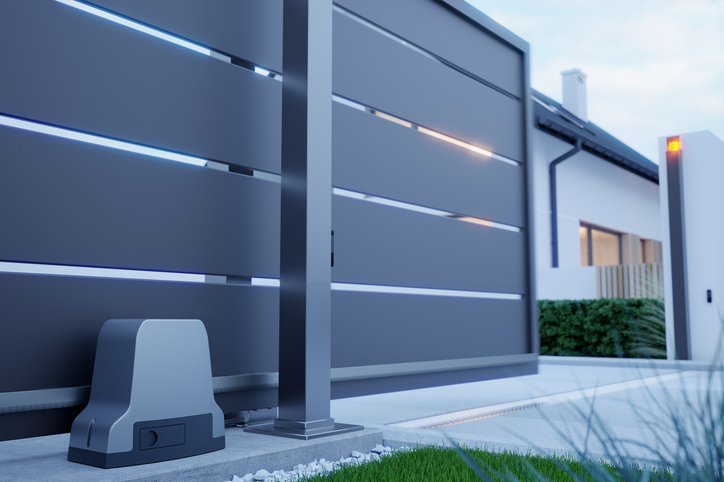
Enhancing Your Fence: Adding Style and Functionality
Your fence is more than just a boundary; it’s an opportunity to express your creativity and enhance the overall look and feel of your outdoor living space. By thinking about some smart details and practical elements, you can turn your fence into a real showstopper that perfectly complements your dream home.
Gates & Entryways: Making a Statement
- Style it up: Think of your gate as the front door to your outdoor space. Choose one that flows seamlessly with your fence design and welcomes people in.
- Extra charm: An archway covered in climbing plants can create a picturesque entryway. It’s like stepping into a secret garden!
- Safety first: Consider adding a keypad or intercom system for extra security and convenience.
Landscaping: Blending with Nature
- Soften the edges: Plants and flowers can do wonders to soften the hard lines of a fence and create a more natural, inviting feel.
- Variety is key: Don’t just stick to basic shrubs. Think about planting colorful flowering vines, ornamental grasses, or even small trees along the fence line.
- Create layers: Combine plants of different heights and textures for a more visually interesting look.
- Bring in nature: Add a small water feature or a bird feeder to create a tranquil and inviting space.
Lighting: Setting the Mood
- Create ambiance: The right lighting can transform your outdoor space into a magical nighttime retreat, and it’ll show off your beautiful fence even after the sun goes down.
- Light the way: Install some subtle landscape lighting along pathways for safety and to create a warm glow.
- Showcase details: Use spotlights to highlight any special features on or around your fence.
- Add a festive touch: String up some fairy lights or install solar-powered lanterns for a touch of whimsy.
Decorative Elements: Adding Personality
- Show your style: Personalize your fence with decorative elements that reflect your unique taste.
- Whimsical touches: Add some playful elements with colorful finials or decorative post caps.
- Create a focal point: Hang a piece of artwork or a mirror on your fence to draw the eye.
- Get creative: You could even stencil a design or paint a mural on a section of the fence. Let your imagination run wild!
Maintenance & Repair: Keeping it Beautiful
- Stay on top of it: Every fence material needs a little TLC. Familiarize yourself with the specific care requirements of your chosen material.
- Fix it fast: If you see any damage, take care of it quickly before it gets worse.
- Keep it fresh: Clean, stain, seal, or repaint your fence from time to time to keep it looking its best.
Beyond Boundaries: Creating Your Outdoor Oasis
By incorporating these extra elements into your fence design, you can create a truly special outdoor space that’s both beautiful and functional. Your fence will become more than just a boundary; it’ll be an integral part of your dream home, adding value, charm, and a reflection of your own personal style.
Conclusion: Choosing the Best Fence Types for Your Home
Choosing the best fence type for my home wasn’t just about function—it was a chance to express my personal style and enhance my outdoor space. I remember feeling a bit overwhelmed by the many options, but it was an exciting process. We’ve covered a lot, from determining what I needed and my budget to exploring various materials and designs. Looking at these choices really helped me figure out what would work best.
Now it’s your turn! Use these ideas and add your own creativity to picture the perfect fence for your home. Adding personal touches, like a unique gate design, made a big difference for me. Remember, there’s no one-size-fits-all solution. What’s most important is finding a fence that suits your style and meets your needs.
Have questions or great fence ideas?
I’d love to hear from you. Drop a comment below, and let’s build a community of homeowners who enjoy creating wonderful outdoor spaces, one fence at a time.
Happy fencing!

